SaaS Marketing Guide
SaaS Digital Marketing 101: How to Run Retargeting Ads
Book a FREE SEO Strategy Consultation >
Further Reading:
- SaaS Marketing Strategy
- SaaS Content Marketing
- SaaS SEO
- SaaS Account Based Marketing
- SaaS Email Marketing
- SaaS Inbound Marketing
- SaaS Retargeting
- SaaS Marketing Budget
- SaaS Marketing Plan
- SaaS Referral Marketing
- SaaS Demand Generation
- SaaS Customer Journey
- SaaS CMO Strategy
- SaaS link building
- SaaS Lead Generation
- SaaS Landing Page Examples
- SaaS CMS
- SaaS Customer Churn
- SaaS Marketing Automation
- SaaS Marketing Campaigns
- SaaS Marketing Agency
- SaaS SEO Agency
- SaaS Link Building Services
Ever visited a website, started to fill out a form, or added a product to your cart, but then left? Chances are, you have. The average web form or ecommerce shopping cart abandonment rate is estimated at close to 70%. That means seven in ten people leave sites before doing what site owners want them to.
When you have abandoned a site, have you ever noticed how often you start seeing ads for that site? They might pop up on the banners of pages you visit or in your social media. It’s no coincidence. It’s a marketing tactic called retargeting, which the site you visited is running.
Ask a digital marketer, and they’ll tell you that retargeting is one of the most effective ways for a website to improve conversions. That’s why its one of the first avenues a SaaS company should explore when looking to get more paying customers.
This brief guide to retargeting ads will help you get started. It will explain why social retargeting is so important and so effective. It will then explain when you might choose to use social media retargeting. Finally, we’ll talk you step-by-step through the perfect Facebook retargeting strategy.
01. What is Retargeting?
Before we get into why retargeting matters and how to do it, it’s worth looking at the basics; starting with what retargeting is. At the basic level, retargeting is when you try to re-engage with someone who visited your site. Somebody who’s shown an interest in what you offer but hasn’t yet converted into a customer.
The process of retargeting lets you focus your marketing efforts on a warm audience. An audience that you know has at least some interest in your products or services. This guide is going to focus on social retargeting; specifically using Facebook.

Later, we’ll talk you through the simple steps you can take to set up your Facebook retargeting strategy. First, let’s look at the basics of how Facebook retargeting works. A short snippet of code installed on your site is all that’s needed to get the ball rolling. That code places a cookie in the browser of your site visitors.
Information is then sent back to Facebook about pages that website users visit. You can use this information to set up specific retargeting ads designed to convert different people. You can tailor the ads according to what individuals did when they visited your site. Before we get to how you can do it, though, let’s talk about why you want to.
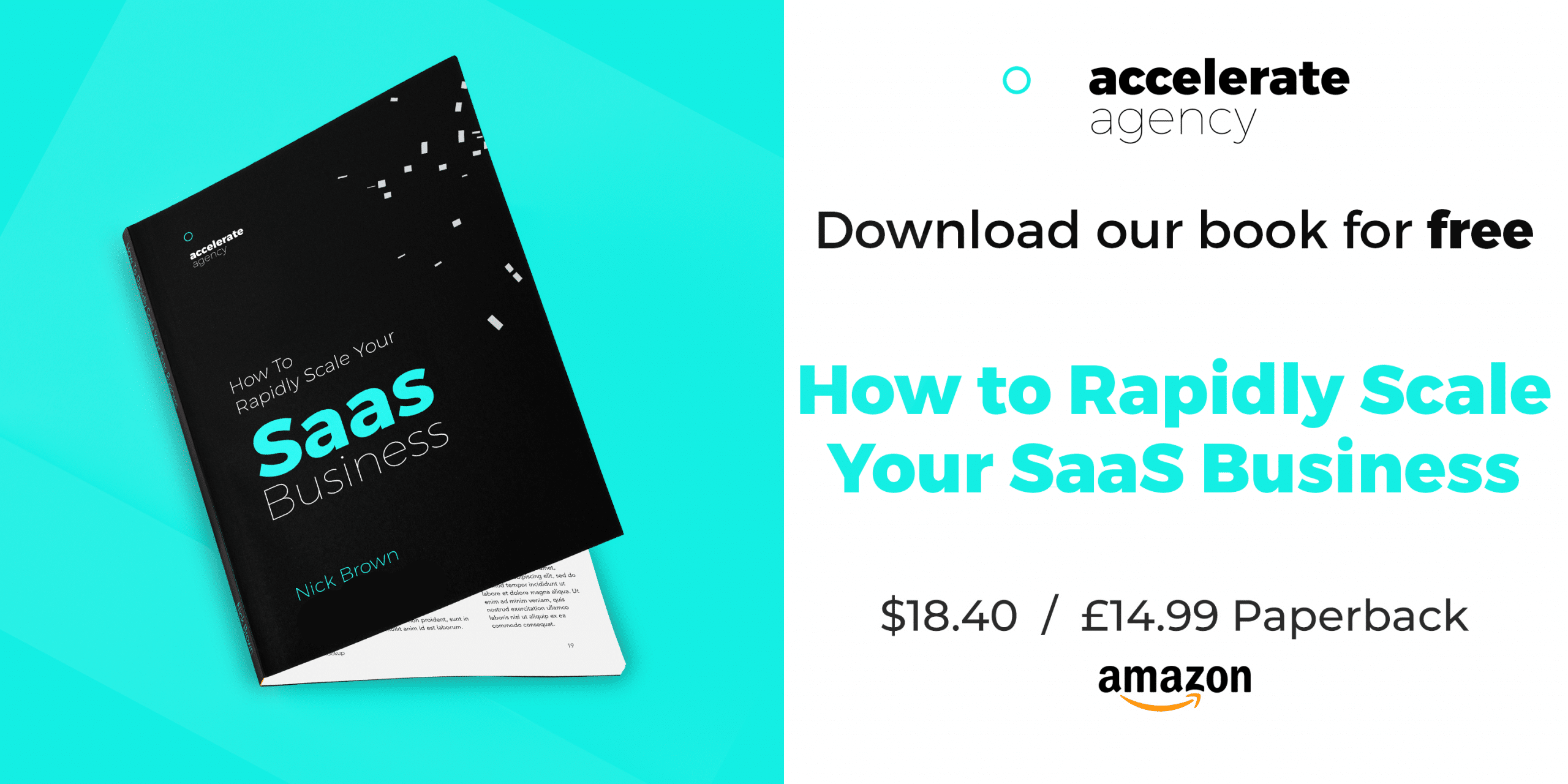
02. Why Social Retargeting is Important
As we mentioned at the outset, website abandonment rates are very high. Most visitors to your pages will leave without completing the action you want from them. Whether that action is to buy a product, register for a service, or join your email list.
Social retargeting gives you a way to target those people. Not only does it provide a method of targeting those people, but it’s also proven to be effective. Connectio shared some compelling stats about how effective retargeting can be:
- Three of four customers notice retargeted ads
- On Facebook, retargeted ads are 76% more likely to be clicked than regular ads
- Retargeting ads lead to a 1046% increase in branded search
There are a few reasons why social retargeting does deliver such good results. Firstly, it’s a channel where you know the target audience is at least somewhat interested. The people you aim the ads at have already visited your site. It might be that they only need a slight nudge or reminder to come back.
Even if those you retarget are farther from buying, you still aren’t starting from scratch. It’s not like content marketing targeting long tail keywords for organic search traffic. They know something about your company and what you offer. That means a much better ROI for retargeting than many marketing alternatives.
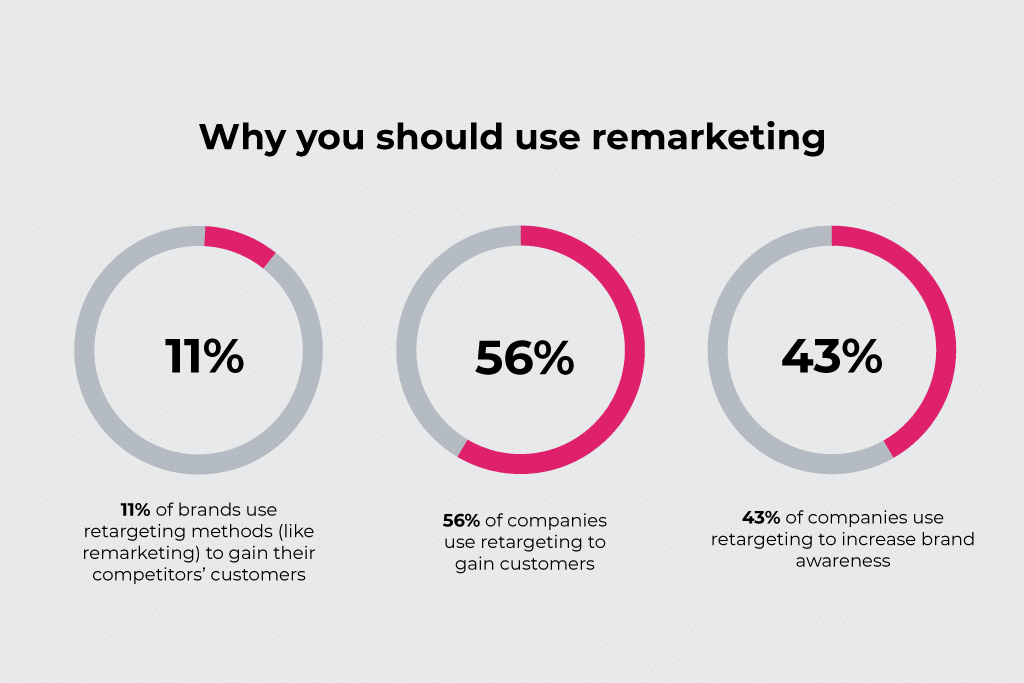
(https://neilpatel.com/blog/a-simple-yet-effective-guide-to-generating-sales-from-remarketing/)
Another reason to think about retargeting is because of the different options it can open up. A good Facebook retargeting strategy is more than hitting site visitors with generic ads. You can tailor what people see according to what they did on your site. We’ll talk at length about the applications of this below.
One other thing that Facebook retargeting can lead to is the creation of lookalike audiences. A lookalike audience is group of Facebook users who share key characteristics. Not only with each other but also with your existing customers or site visitors. If you create it correctly, a lookalike audience will be a long list of your ideal customers.
Assuming you have a Facebook business account, it’s easy to create lookalike audiences:
- Head to ‘Audiences’ in your account
- Click ‘Create Audience’ and choose the ‘Lookalike Audience’ alternative
- Choose your source. It makes sense for this to be the custom audience you create for your retargeting
- Choose the nation or nations from which you want to draw your lookalike audience
- Select the desired audience size using the slider
- Click ‘Create Audience’, and your list of prospective customers will be ready in a matter of hours
You might by now be convinced of the importance of a good Facebook retargeting strategy. If not, perhaps looking at some real-world examples of when retargeting can work will win you over.
03. When Would You Use Social Media Retargeting?
Social media is an increasingly useful tool for marketing. There are lots of ways that businesses in all different niches can use it. Many firms now use social networks for things as varied as sales prospecting and SEO. Retargeting is a great way to use social media to improve your website’s conversions.
As a SaaS business, there are many examples of times retargeting may prove invaluable. Take, for instance, if you are looking to promote a particular piece of content on your site. You may have produced a fantastic blog post that you know will wow anyone who sees it. Social media retargeting can help you to get your post seen by a wider audience.
By following the instructions you’ll find below, you can set up a retargeting campaign with that aim in mind. You might choose to target any site visitors who’ve previously viewed one of your blog posts. Your ad can then tell them that you’ve produced some juicy new content for them to read.
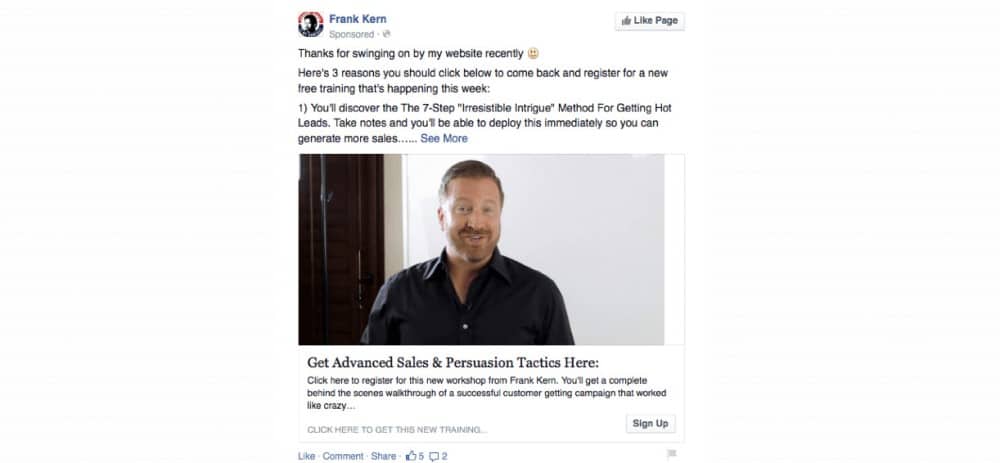
(https://swiped.co/file/frankkern-facebook-retargeting/)
Retargeting is also great for persuading people to join a webinar or sign up for something else you offer. The above example shows how this can work in practice. By knowing that someone has been on your site, you can address them more directly. You can thank them for checking out your content and then sell them on what else you offer.
Whatever the exact aim of your retargeting, it often pays to include an incentive in your ads. Some of the best retargeting ads tempt their targets with a specific reward. You might, for instance, run a special offer only for those who see the ads. Alternatively, you could offer the targets of the ads a special content upgrade.
04. How to Set Up a Facebook Retargeting Campaign
To get started with Facebook retargeting, you need a Facebook Ads Manager account. If you’re active in promoting your firm through social media, you should already have this up and running.
Log in to your account and then head on over to Facebook Ads Manager. From there, you can take the first step toward retargeting. That first step is to create a custom audience made up of visitors to your website. They’re the Facebook users who will be going to see your retargeting ads.
Creating a Custom Audience
Once you’ve accessed your Ads Manager account, you need to go to the ‘Audiences’ section. If it’s your first time creating an audience, you’ll see the following page: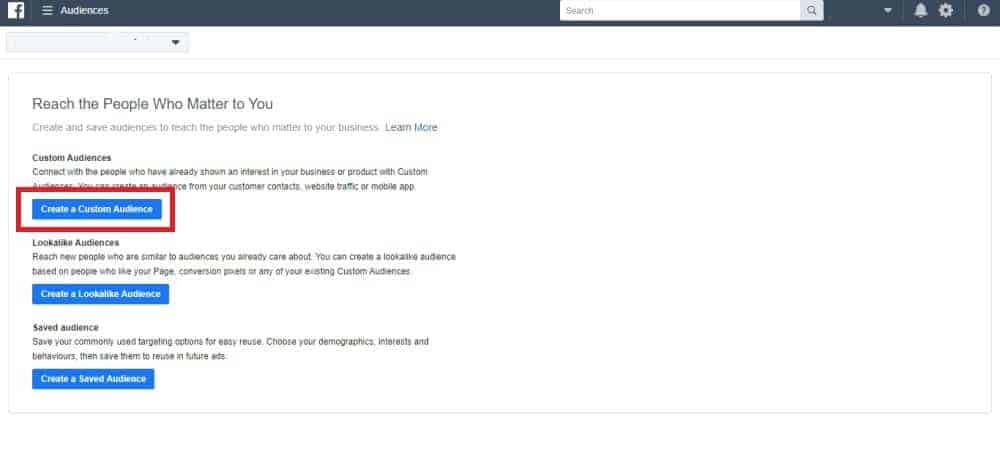
From that page, click the ‘Create Custom Audience’ button. If you’ve already created audiences, the same option can be found on the ‘Create Audience’ drop-down menu.
On the next page, choose the ‘Website Traffic’ option, as shown below:
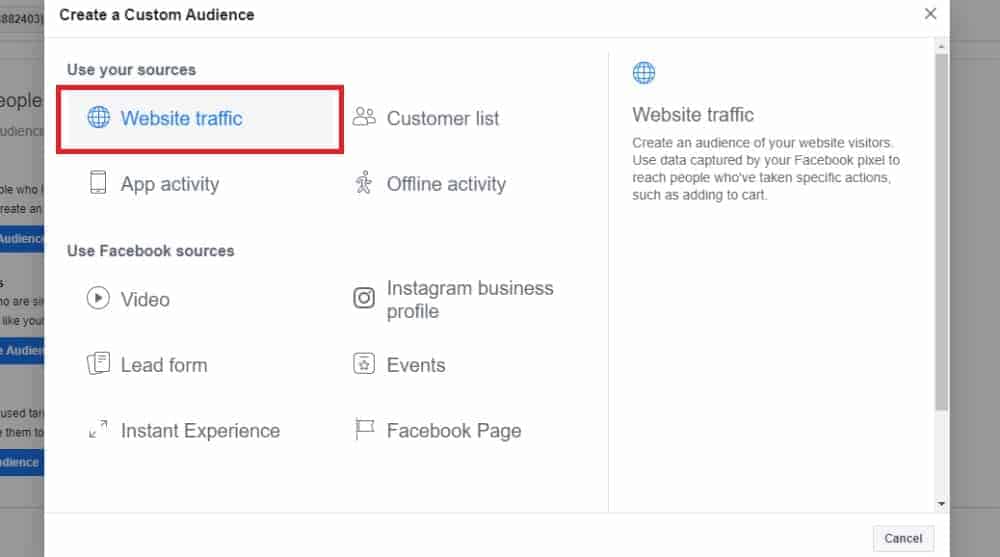
If you don’t already have a Facebook Pixel, you’ll then be prompted to create one. The Facebook Pixel is the snippet of code which puts a cookie in the browser of your site visitors. You need to have the pixel set up for Custom Audiences and retargeting ads to work. In the same way, as you need to add Google Analytics tracking code to your site for that platform to work.
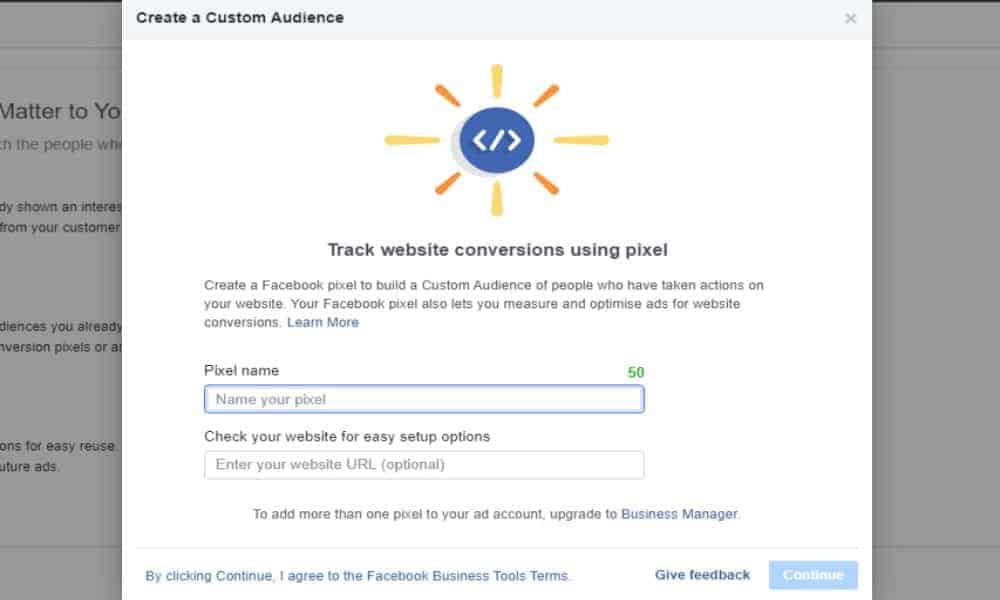
Once you’ve created your Facebook Pixel, or if you had one already, you can then move on to the next step. That’s setting up the rules for your Custom Audience. These are what determine who falls within the audience and who doesn’t.
You have several options when it comes to those rules. Different alternatives let you create audiences of people who fulfill certain criteria. Criteria such as the following:
- Anyone who has visited your website
- Only people who have visited a particular page or pages on the site
- Visitors who go to one page but not another
- Former visitors to your site who haven’t been back in a certain amount of time
Those are just a few examples. You can tailor your Custom Audience to suit your circumstances. The last thing you need to do is to name your audience. You can also give it a description if desired. Then, click ‘Create Audience,’ and you’re done. You’ll be able to select this audience for any future Facebook Ad you create.
How to Create Facebook Ads
Setting up Custom Audiences is the lion’s share of the work involved in Facebook retargeting. All you have to do now is create the ads you want your audience to see. You can create these ads through Ad Manager in precisely the same way as any others.

The only difference comes when you choose the audience for the relevant ad set. For your retargeting campaign, you need to select the Custom Audience you’ve just created. Of course, you will also want to tailor the ad’s creative and text to the specific aims of your campaign.
Your Facebook retargeting strategy may aim to turn one time visitors into customers. Your ad’s creative and copy, in that case, will want to sell them the benefits of doing so. It’s only like tailoring your website’s content to its target market.
05. Retarget to Rekindle The Interest of Your Audience
As the owner of a SaaS business, you’ll spend a lot of time trying to get more traffic to your website. It’s unavoidable, however, that most of the people who do visit will leave sooner than you’d like. Many will abandon your pages without buying from you or filling in a contact form. Those visitors don’t have to be lost to you forever.
Social retargeting is a way for you to rekindle the interest those visitors have shown in you. It allows you to target them directly in a way that’s proven to deliver results. Facebook retargeting ads are far more impactful than standard ads. Such ads also help to boost your site’s branded search traffic. That’s why an excellent Facebook retargeting strategy is so valuable.
Setting up retargeting campaigns could hardly be more straightforward. All you need to do is to create Custom Audiences and related ads on Facebook. It’s a good idea to create as many different versions of each as you can. That way, you can be sure you’re getting the most out of your retargeting. If you do implement the perfect strategy, you might be surprised at how good your results are.
